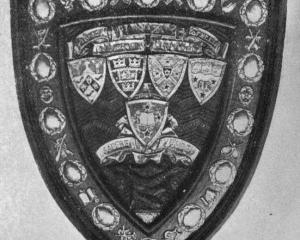The hull of the machine (says the New Zealand Herald) is 24ft 6in long, with a beam of 3ft at the bow and tapering to a knife edge at the stern, beyond which the rudder projects about 3ft, giving the machine a total length of 27ft 6in, compared with its width over all of 41ft 6in.
The lower surface of the hull is flat, with a step immediately below the engine, so that just before rising into the air only a small portion of the forward section is in contact with the water.
The greater part of the hull is divided into five water-tight compartments, any one of which is sufficient to sustain the whole machine upon the water, even if all the others were flooded.
About 4ft from the bow the pilot and passenger seats are placed, and the view from them is entirely free from obstruction, the main structure of the machine being all behind the seating accommodation.
With the exception of this opening, the hull is closed.
The engine is a 10-cylinder, 4-cycle Anzani, which is designed to develop 70-80 h.p. at 1250 revolutions per minute.
Its weight, complete, with magneto and carburettor, is 238lb.
With this engine, one of the lowest-powered ever fitted in a flying boat, the machine attains a velocity of about 50 miles per hour when running on the water, and over 60 miles in the air.
The propeller is 8ft 4½in diameter, tipped with brass caps to prevent injury to the blades from flying spray.
The total weight of the machine, without the pilot, is 1200lb, which is fully 200lb less than that of any other flying-boat of similar size previously built.
This material, economy in weight has been secured by the most ingenious devices for the reduction of the weight of every part, without endangering the strength and the stability of the complete structure.
• Notwithstanding the advent of the motor, some at least have not forgotten the art of walking (says the Bruce Herald).
A lady recently missed the train from Dunedin to Clarendon, so she took the next train to Mosgiel, and then quietly strolled home, arriving before midnight.
• Reuter's correspondent states that the Australasian and Turkish trenches at Sari Bahr are in some cases only 30 yards apart.
In many cases the colonials catch the Turkish grenades and immediately fling them back, so that they explode in the Turkish trenches.
The Australasians are continually playing tricks.
One filled a jam tin with cotton wool soaked in oil, set it alight, and flung it into a trench.
The Turks scattered in all directions, amid the colonials' cheers.
• Mr Green, of Martins Bay, was in Queenstown last week (says the Mail), and, on being questioned regarding the presence of red deer in the valleys en route, stated that although he had seen some of the animals and numerous tracks he was not impressed with the necessity for opening the season yet.
The deer were mostly in the Routeburn and Mr Green says that he has seen an occasional one in the Hollyford Valley.
Most of the deer seen were good-looking animals. - ODT, 27.5.1915.
• COPIES OF PICTURE AVAILABLE FROM ODT FRONT OFFICE, LOWER STUART ST, OR WWW.OTAGOIMAGES.CO.NZ












